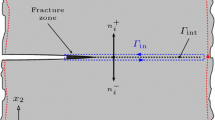Abstract
Experimentally observed crack opening displacements are employed as the solution of the multiple crack interaction problem. Then the near and far fields are reconstructed analytically by means of the double layer potential technique. Evaluation of the effective stress intensity factor fesulting from the interaction of the main crack and its surrounding crazes in addition to the remotely applied load is presented as an illustrative example. It is shown that crazing (as well as microcracking) may constitute an alternative mechanism to Dugdale-Barenblatt models responsible for the cancellation of the singularity at the crack tip.
Résumé
Pour solutionner le problème d'interactions multiples des fissures, on utilise les COD observées expérimentalement. On reconstitue ensuite analytiquement les champs proche et lointain à l'aide de la technique du potentiel en deux couches. Comme exemple illustratif, on présente une évaluation du facteur effectif d'intensité de contraintes résultant de l'interaction d'une fissure principale avec les brisures qui l'entourent, ainsi que de la charge appliquée à distance. On montre que le phénomène de brisures-comme celui de microfissuration-constitue une alternative aux modèles de Dugdale-Barenblatt auxquels on doit la suppression de la singularité à l'extrémité de la fissure.
Similar content being viewed by others
References
S. Shiue and S. Lee, Engineering Fracture Mechanics 22 (1985) 1105–1115.
L.R. Rose, International Journal of Fracture 31 (1986) 233–242.
M. Kachanov, International Journal of Solids and Structures 23 (1987) 23–43.
R.G. Hoagland and J.D. Embry, Journal of the American Ceramic Society 66 (1980) 404–410.
S.K. Kanaun, in Elastic Media with Microstructure, I.A. Kunin (ed.) Vol. 2, Springer, Berlin (1983) Chapter 7.
A. Chudnovsky and M. Kachanov, Letters in Applied Engineering Science 21 (1983) 1009–1018.
A. Chudnovsky, A. Dolgopolsky and M. Kachanov, in Advances in Fracture Research, Proceedings IFC6, Vol. 2, S.R. Valluri et al. (eds.), Pergamon Press, Oxford (1984) 825–832.
A. Chudnovsky, A. Dolgopolsky and M. Kachanov, International Journal of Solids and Structures 23 (1987) 1–21.
J. Botsis, A. Chudnovsky and A. Moet, International Journal of Fracture 33 (1986) 263–276.
H. Tada, P.C. Paris and G.R. Irwin, The Stress Analysis of Cracks Handbook, Del Research Corporation, Hellertown, PA (1973) 2.27.
A.A. Rubenstein, Journal of Applied Mechanics, Transactions of the ASME 53 (1986) 505–510.
D.S. Dugdale, Journal of the Mechanics and Physics of Solids 8 (1960) 100.
G.I. Barenblatt, Advances in Applied Mechanics 7 (1962) 55.
Author information
Authors and Affiliations
Rights and permissions
About this article
Cite this article
Chudnovsky, A., Ben Ouezdon, M. Semi-empirical crack tip analysis. Int J Fract 37, 3–11 (1988). https://doi.org/10.1007/BF00017819
Received:
Accepted:
Issue Date:
DOI: https://doi.org/10.1007/BF00017819



